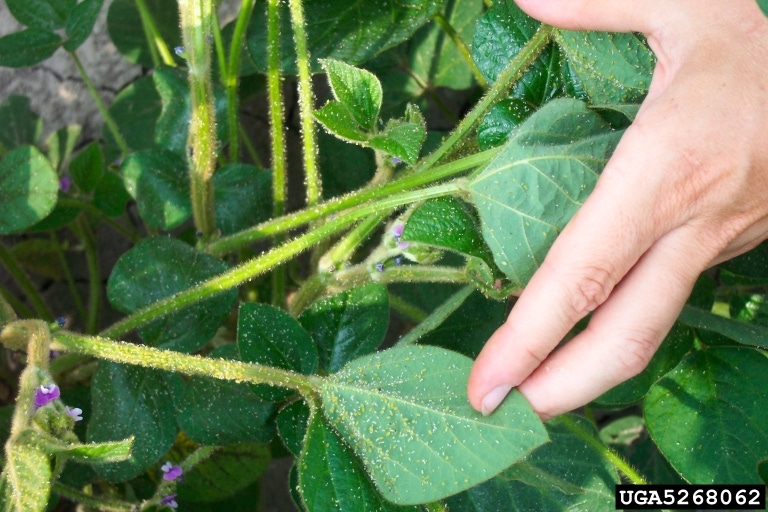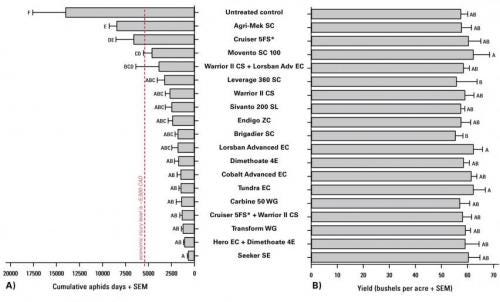August 10, 2018

Source: Iowa State University
Soybean aphid is the most important insect pest of soybean in Iowa. Foliar insecticides, mostly pyrethroids and organophosphates, have been the primary management tactic for soybean aphid in Iowa since 2001. Regular scouting and timely treatments will protect yield. Our research and extension program at Iowa State University (ISU) is focused on evaluating insecticide efficacy for soybean aphid on a wide range of products. We are also screening soybean aphid populations for pyrethroid resistance in northern Iowa.
Soybean aphid. Photo by Matt Kaiser.
Project Description
Evaluations are established at two locations every summer (see 2005-2017 reports). Here, we show a two-year summary from the ISU Northwest Research Farm, near Sutherland, IA. There were 12 treatments in 2016 and 17 treatments in 2017. Soybean aphids were counted on whole plants from June through September. Soybean aphids colonized plots in late June and July in both years. Foliar insecticide applications were made with a back-pack sprayer when populations reached the economic threshold. The seasonal exposure of aphids on plants was converted into cumulative aphid days (CAD) and yield was estimated to compare treatments. We expect to see treatment differences when CAD exceeds the economic injury level of 5,500 (red lines in Figures. 1A and 2A).
2016 summary of A) cumulative aphid days (CAD) and B) yield. Means with a unique letter are significantly different (alpha = 0.10). Asterisks indicate pesticidal seed treatment.

2017 summary of A) cumulative aphid days (CAD) and B) yield. Means with a unique letter are significantly different (alpha = 0.10). Asterisks indicate pesticidal seed treatment.
Summary
Aphids reached the economic threshold in both years; however, aphids were sprayed earlier in 2016 (9 August) than in 2017 (18 August).
When aphids exceeded the threshold before seed set in 2016, foliar insecticides provided significant yield protection (Figure 1B). When aphids exceeded the threshold after seed set in 2017, there was no yield benefit to the foliar insecticides (Figure 2B).
Plots with insecticidal seed treatments had significantly higher CAD than foliar insecticide treatments in both years (Figures. 1A and 2A).
Foliar insecticides provided good efficacy in both years. We have not observed pyrethroid resistance at either location to date.
Recommendations
Insecticidal seed treatments are not recommended to manage soybean aphid in Iowa, as they do not provide a consistent reduction of CAD (Figures. 1A and 2A).
Scouting and using foliar insecticides when aphids exceed the economic threshold (250 aphids on 80% of plants) before seed set will provide a 5-10 bushel yield increase (Figure 1B).
Late-season aphid infestations may not impact yield; applying insecticides after seed set may not result in a return on investment (Figure 2B).
Pyrethroid resistance is an emerging issue in the Midwest. It is important to check for efficacy after applications to look for resistant aphids.
Originally posted by Iowa State University.
You May Also Like




